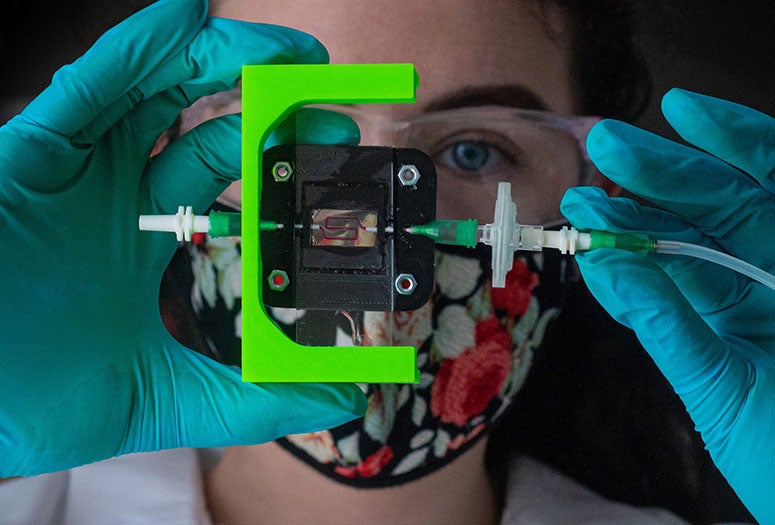HOUSTON – (July 26, 2021) – Rice University bioengineers are using 3D printing and smart biomaterials to create an insulin-producing implant for Type 1 diabetics.
The three-year project is a partnership between the laboratories of Omid Veiseh and Jordan Miller that's supported by a grant from JDRF, the leading global funder of diabetes research. Veiseh and Miller will use insulin-producing beta cells made from human stem cells to create an implant that senses and regulates blood glucose levels by responding with the correct amount of insulin at a given time.
Veiseh, an assistant professor of bioengineering, has spent more than a decade developing biomaterials that protect implanted cell therapies from the immune system. Miller, an associate professor of bioengineering, has spent more than 15 years researching techniques to 3D print tissues with vasculature, or networks of blood vessels.
"If we really want to recapitulate what the pancreas normally does, we need vasculature," Veiseh said. "And that's the purpose of this grant with JDRF. The pancreas naturally has all these blood vessels, and cells are organized in particular ways in the pancreas. Jordan and I want to print in the same orientation that exists in nature."
Type 1 diabetes is an autoimmune disease that causes the pancreas to stop producing insulin, the hormone that controls blood-sugar levels. About 1.6 million Americans live with Type 1 diabetes, and more than 100 cases are diagnosed each day. Type 1 diabetes can be managed with insulin injections. But balancing insulin intake with eating, exercise and other activities is difficult. Studies estimate that fewer than one-third of Type 1 diabetics in the U.S. consistently achieve target blood glucose levels.
Veiseh's and Miller's goal is to show their implants can properly regulate blood glucose levels of diabetic mice for at least six months. To do that, they'll need to give their engineered beta cells the ability to respond to rapid changes in blood sugar levels.
"We must get implanted cells in close proximity to the bloodstream so beta cells can sense and respond quickly to changes in blood glucose," Miller said.
Ideally, insulin-producing cells will be no more than 100 microns from a blood vessel, he said.
"We're using a combination of pre-vascularization through advanced 3D bioprinting and host-mediated vascular remodeling to give each implant several shots at host integration," Miller said.
The insulin-producing cells will be protected with a hydrogel formulation developed by Veiseh, who is also a Cancer Prevention and Research Institute of Texas Scholar. The hydrogel material, which has proven effective for encapsulating cell treatments in bead-sized spheres, has pores small enough to keep the cells inside from being attacked by the immune system but large enough to allow passage of nutrients and life-giving insulin.
"Blood vessels can go inside of them," Veiseh said of the hydrogel compartments. "At the same time, we have our coating, our small molecules that prevent the body from rejecting the gel. So it should harmonize really well with the body."
If the implant is too slow to respond to high or low blood sugar levels, the delay can produce a roller coaster-like effect, where insulin levels repeatedly rise and fall to dangerous levels.
"Addressing that delay is a huge problem in this field," Veiseh said. "When you give the mouse -- and ultimately a human -- a glucose challenge that mimics eating a meal, how long does it take that information to reach our cells, and how quickly does the insulin come out?"
By incorporating blood vessels in their implant, he and Miller hope to allow their beta-cell tissues to behave in a way that more closely mimics the natural behavior of the pancreas.
-30-
High-resolution IMAGES are available for download at:
https://news-network.rice.edu/news/files/2021/07/0719_DIABETES_220a-lg.jpg
CAPTION: Rice University bioengineers are designing a vascularized, insulin-producing implant for Type 1 diabetes. Graduate student Madison Royse demonstrates a laboratory setup for testing blood flow through 3D-printed hydrogels that can be turned into living tissue. (Photo by Jeff Fitlow/Rice University)
https://news-network.rice.edu/news/files/2021/07/0719_DIABETES-6pnW-lg.jpg
CAPTION: To 3D print vascularized hydrogels that can be turned into living tissue, Rice University bioengineers use (top left) a nontoxic liquid polymer that is (top middle) solidified one layer at a time by blue light. Yellow food coloring absorbs the light, allowing for the creation of passageways for flowing blood. Postdoctoral researcher Kristen Means (top right) displays a printed hydrogel that was secured (bottom right and middle) in a plastic housing for graduate student Madison Royse's (bottom left) blood-flow demonstration using liquid dye. (Photos by Jeff Fitlow/Rice University)
https://news-network.rice.edu/news/files/2021/07/0719_DIABETES-ov-med.jpg
CAPTION: Omid Veiseh is an assistant professor of bioengineering at Rice University and a Cancer Prevention and Research Institute of Texas Scholar. (Photo courtesy of Omid Veiseh)
https://news-network.rice.edu/news/files/2021/07/0719-DIABETES-jm-med.jpg
CAPTION: Jordan Miller is an associate professor of bioengineering at Rice University. (Photo by Jeff Fitlow/Rice University)
This release can be found online at news.rice.edu.
Follow Rice News and Media Relations via Twitter @RiceUNews.
Located on a 300-acre forested campus in Houston, Rice University is consistently ranked among the nation’s top 20 universities by U.S. News & World Report. Rice has highly respected schools of Architecture, Business, Continuing Studies, Engineering, Humanities, Music, Natural Sciences and Social Sciences and is home to the Baker Institute for Public Policy. With 3,978 undergraduates and 3,192 graduate students, Rice’s undergraduate student-to-faculty ratio is just under 6-to-1. Its residential college system builds close-knit communities and lifelong friendships, just one reason why Rice is ranked No. 1 for lots of race/class interaction and No. 1 for quality of life by the Princeton Review. Rice is also rated as a best value among private universities by Kiplinger’s Personal Finance.




